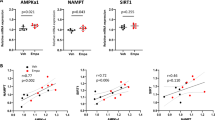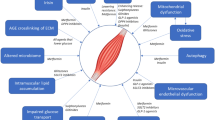Abstact
With advancing age, the incidence of sarcopenia increases, eventually leading to a cascade of adverse events. However, there is currently a lack of effective pharmacological treatment for sarcopenia. Sodium-glucose co-transporter 2 inhibitor (SGLT2i) empagliflozin demonstrates anti-fibrotic capabilities in various organs. This study aims to determine whether empagliflozin can improve skeletal muscle fibrosis induced by sarcopenia in naturally aging mice. A natural aging model was established by feeding male mice from 13 months of age to 19 months of age. A fibrosis model was created by stimulating skeletal muscle fibroblasts with TGF-β1. The Forelimb grip strength test assessed skeletal muscle function, and expression levels of COL1A1, COL3A1, and α-SMA were analyzed by western blot, qPCR, and immunohistochemistry. Additionally, levels of AMPKα/MMP9/TGFβ1/Smad signaling pathways were examined. In naturally aging mice, skeletal muscle function declines, expression of muscle fibrosis markers increases, AMPKα expression is downregulated, and MMP9/TGFβ1/Smad signaling pathways are upregulated. However, treatment with empagliflozin reverses this phenomenon. At the cellular level, empagliflozin exhibits similar anti-fibrotic effects, and these effects are attenuated by Compound C and siAMPKα. Empagliflozin exhibits anti-fibrotic effects, possibly associated with the AMPK/MMP9/TGFβ1/Smad signaling pathways.






Similar content being viewed by others
Data availability
Data analyzed during the study is not publicly available but can be available on request to corresponding author.
References
Aragon AA, Tipton KD, Schoenfeld BJ (2023) Age-related muscle anabolic resistance: inevitable or preventable? Nutr Rev 81:441–454. https://doi.org/10.1093/nutrit/nuac062
Arthur ST, Cooley ID (2012) The effect of physiological stimuli on sarcopenia; impact of Notch and Wnt signaling on impaired aged skeletal muscle repair. Int J Biol Sci 8:731–760. https://doi.org/10.7150/ijbs.4262
Brack AS, Conboy MJ, Roy S, Lee M, Kuo CJ, Keller C, Rando TA (2007) Increased Wnt signaling during aging alters muscle stem cell fate and increases fibrosis. Science 317:807–810
Cai C, Guo Z, Chang X, Li Z, Wu F, He J, Cao T, Wang K, Shi N, Zhou H, Toan S, Muid D, Tan Y (2022) Empagliflozin attenuates cardiac microvascular ischemia/reperfusion through activating the AMPKα1/ULK1/FUNDC1/mitophagy pathway. Redox Biol 52:102288. https://doi.org/10.1016/j.redox.2022.102288
Chen S, Coronel R, Hollmann MW, Weber NC, Zuurbier CJ (2022) Direct cardiac effects of SGLT2 inhibitors. Cardiovasc Diabetol 21:45. https://doi.org/10.1186/s12933-022-01480-1
Cruz-Jentoft AJ, Sayer AA (2019) Sarcopenia. Lancet 393:2636–2646. https://doi.org/10.1016/S0140-6736(19)31138-9
Defronzo RA, Norton L, Abdul-Ghani M (2017) Renal, metabolic and cardiovascular considerations of SGLT2 inhibition. Nat Rev Nephrol 13:11–26. https://doi.org/10.1038/nrneph.2016.170
El-Horany HE-S, Atef MM, Abdel Ghafar MT, Fouda MH, Nasef NA, Hegab II, Helal DS, Elseady W, Hafez YM, Hagag RY, Seleem MA, Saleh MM, Radwan DA, Abd El-Lateef AE, Abd-Ellatif RN (2023) Empagliflozin ameliorates bleomycin-induced pulmonary fibrosis in rats by modulating Sesn2/AMPK/Nrf2 signaling and targeting ferroptosis and autophagy. Int J Mol Sci. https://doi.org/10.3390/ijms24119481
Fitchett D, Zinman B, Wanner C, Lachin JM, Hantel S, Salsali A, Johansen OE, Woerle HJ, Broedl UC, Inzucchi SE (2016) Heart failure outcomes with empagliflozin in patients with type 2 diabetes at high cardiovascular risk: results of the EMPA-REG OUTCOME® trial. Eur Heart J 37:1526–1534. https://doi.org/10.1093/eurheartj/ehv728
Gastaldelli A, Cusi K, Fernández Landó L, Bray R, Brouwers B, Rodríguez Á (2022) Effect of tirzepatide versus insulin degludec on liver fat content and abdominal adipose tissue in people with type 2 diabetes (SURPASS-3 MRI): a substudy of the randomised, open-label, parallel-group, phase 3 SURPASS-3 trial. Lancet Diabetes Endocrinol 10:393–406. https://doi.org/10.1016/S2213-8587(22)00070-5
Herzig S, Shaw RJ (2018) AMPK: guardian of metabolism and mitochondrial homeostasis. Nat Rev Mol Cell Biol 19:121–135. https://doi.org/10.1038/nrm.2017.95
Hills CE, Squires PE (2011) The role of TGF-β and epithelial-to mesenchymal transition in diabetic nephropathy. Cytokine Growth Factor Rev 22:131–139. https://doi.org/10.1016/j.cytogfr.2011.06.002
Ida S, Kaneko R, Imataka K, Okubo K, Shirakura Y, Azuma K, Fujiwara R, Murata K (2021) Effects of antidiabetic drugs on muscle mass in type 2 diabetes mellitus. Curr Diabetes Rev 17:293–303. https://doi.org/10.2174/1573399816666200705210006
Kang S, Verma S, Hassanabad AF, Teng G, Belke DD, Dundas JA, Guzzardi DG, Svystonyuk DA, Pattar SS, Park DSJ, Turnbull JD, Duff HJ, Tibbles LA, Cunnington RH, Dyck JRB, Fedak PWM (2020) Direct effects of empagliflozin on extracellular matrix remodelling in human cardiac myofibroblasts: novel translational clues to explain EMPA-REG OUTCOME results. Can J Cardiol 36:543–553. https://doi.org/10.1016/j.cjca.2019.08.033
Koyani CN, Plastira I, Sourij H, Hallström S, Schmidt A, Rainer PP, Bugger H, Frank S, Malle E, Von Lewinski D (2020) Empagliflozin protects heart from inflammation and energy depletion via AMPK activation. Pharmacol Res 158:104870. https://doi.org/10.1016/j.phrs.2020.104870
Lan HY (2011) Diverse roles of TGF-β/Smads in renal fibrosis and inflammation. Int J Biol Sci 7:1056–1067
Li C, Zhang J, Xue M, Li X, Han F, Liu X, Xu L, Lu Y, Cheng Y, Li T, Yu X, Sun B, Chen L (2019) SGLT2 inhibition with empagliflozin attenuates myocardial oxidative stress and fibrosis in diabetic mice heart. Cardiovasc Diabetol 18:15. https://doi.org/10.1186/s12933-019-0816-2
Li L, Li Q, Huang W, Han Y, Tan H, An M, Xiang Q, Zhou R, Yang L, Cheng Y (2021) Dapagliflozin alleviates hepatic steatosis by restoring autophagy via the AMPK-mTOR pathway. Front Pharmacol 12:589273. https://doi.org/10.3389/fphar.2021.589273
Lin K, Yang N, Luo W, Qian J-F, Zhu W-W, Ye S-J, Yuan C-X, Xu D-Y, Liang G, Huang W-J, Shan P-R (2022) Direct cardio-protection of Dapagliflozin against obesity-related cardiomyopathy via NHE1/MAPK signaling. Acta Pharmacol Sin 43:2624–2635. https://doi.org/10.1038/s41401-022-00885-8
Liu X, Xu C, Xu L, Li X, Sun H, Xue M, Li T, Yu X, Sun B, Chen L (2020) Empagliflozin improves diabetic renal tubular injury by alleviating mitochondrial fission via AMPK/SP1/PGAM5 pathway. Metabolism 111:154334. https://doi.org/10.1016/j.metabol.2020.154334
Liu X, Zhao L, Gao Y, Chen Y, Tian Q, Son JS, Chae SA, De Avila JM, Zhu M-J, Du M (2023) AMP-activated protein kinase inhibition in fibro-adipogenic progenitors impairs muscle regeneration and increases fibrosis. J Cachexia Sarcopenia Muscle 14:479–492. https://doi.org/10.1002/jcsm.13150
Lu Y-P, Wu H-W, Zhu T, Li X-T, Zuo J, Hasan AA, Reichetzeder C, Delic D, Yard B, Klein T, Krämer BK, Zhang Z-Y, Wang X-H, Yin L-H, Dai Y, Zheng Z-H, Hocher B (2022) Empagliflozin reduces kidney fibrosis and improves kidney function by alternative macrophage activation in rats with 5/6-nephrectomy. Biomed Pharmacother 156:113947. https://doi.org/10.1016/j.biopha.2022.113947
Lyu A-K, Zhu S-Y, Chen J-L, Zhao Y-X, Pu D, Luo C, Lyu Q, Fan Z, Sun Y, Wu J, Zhao K-X, Xiao Q (2019) Inhibition of TLR9 attenuates skeletal muscle fibrosis in aged sarcopenic mice via the p53/SIRT1 pathway. Exp Gerontol 122:25–33. https://doi.org/10.1016/j.exger.2019.04.008
Meng X-M, Nikolic-Paterson DJ, Lan HY (2016) TGF-β: the master regulator of fibrosis. Nat Rev Nephrol 12:325–338. https://doi.org/10.1038/nrneph.2016.48
Moon JS, Hong JH, Jung YJ, Ferrannini E, Nauck MA, Lim S (2022) SGLT-2 inhibitors and GLP-1 receptor agonists in metabolic dysfunction-associated fatty liver disease. Trends Endocrinol Metab 33:424–442. https://doi.org/10.1016/j.tem.2022.03.005
Neutel CHG, Wesley CD, Van Praet M, Civati C, Roth L, De Meyer GRY, Martinet W, Guns P-J (2023) Empagliflozin decreases ageing-associated arterial stiffening and vascular fibrosis under normoglycemic conditions. Vascul Pharmacol 152:107212. https://doi.org/10.1016/j.vph.2023.107212
Quagliariello V, De Laurentiis M, Rea D, Barbieri A, Monti MG, Carbone A, Paccone A, Altucci L, Conte M, Canale ML, Botti G, Maurea N (2021) The SGLT-2 inhibitor empagliflozin improves myocardial strain, reduces cardiac fibrosis and pro-inflammatory cytokines in non-diabetic mice treated with doxorubicin. Cardiovasc Diabetol 20:150. https://doi.org/10.1186/s12933-021-01346-y
Rahelić D, Javor E, Lucijanić T, Skelin M (2017) Effects of antidiabetic drugs on the incidence of macrovascular complications and mortality in type 2 diabetes mellitus: a new perspective on sodium-glucose co-transporter 2 inhibitors. Ann Med 49:51–62. https://doi.org/10.1080/07853890.2016.1226514
Ryall JG, Schertzer JD, Lynch GS (2008) Cellular and molecular mechanisms underlying age-related skeletal muscle wasting and weakness. Biogerontology 9:213–228. https://doi.org/10.1007/s10522-008-9131-0
Santos-Gallego CG, Requena-Ibanez JA, San Antonio R, Ishikawa K, Watanabe S, Picatoste B, Flores E, Garcia-Ropero A, Sanz J, Hajjar RJ, Fuster V, Badimon JJ (2019) Empagliflozin ameliorates adverse left ventricular remodeling in nondiabetic heart failure by enhancing myocardial energetics. J Am Coll Cardiol 73:1931–1944. https://doi.org/10.1016/j.jacc.2019.01.056
Santos-Gallego CG, Requena-Ibanez JA, San Antonio R, Garcia-Ropero A, Ishikawa K, Watanabe S, Picatoste B, Vargas-Delgado AP, Flores-Umanzor EJ, Sanz J, Fuster V, Badimon JJ (2021) Empagliflozin Ameliorates diastolic dysfunction and left ventricular fibrosis/stiffness in nondiabetic heart failure: a multimodality study. JACC Cardiovasc Imaging 14:393–407. https://doi.org/10.1016/j.jcmg.2020.07.042
Shang G-K, Han L, Wang Z-H, Liu Y-P, Yan S-B, Sai W-W, Wang D, Li Y-H, Zhang W, Zhong M (2020) Sarcopenia is attenuated by TRB3 knockout in aging mice via the alleviation of atrophy and fibrosis of skeletal muscles. J Cachexia Sarcopenia Muscle 11:1104–1120. https://doi.org/10.1002/jcsm.12560
Shen Y, Cheng L, Xu M, Wang W, Wan Z, Xiong H, Guo W, Cai M, Xu F (2023) SGLT2 inhibitor empagliflozin downregulates miRNA-34a-5p and targets GREM2 to inactivate hepatic stellate cells and ameliorate non-alcoholic fatty liver disease-associated fibrosis. Metabolism 146:155657. https://doi.org/10.1016/j.metabol.2023.155657
Shentu Y, Li Y, Xie S, Jiang H, Sun S, Lin R, Chen C, Bai Y, Zhang Y, Zheng C, Zhou Y (2021) Empagliflozin, a sodium glucose cotransporter-2 inhibitor, ameliorates peritoneal fibrosis via suppressing TGF-β/Smad signaling. Int Immunopharmacol 93:107374. https://doi.org/10.1016/j.intimp.2021.107374
Siapoush S, Rezaei R, Alavifard H, Hatami B, Zali MR, Vosough M, Lorzadeh S, Łos MJ, Baghaei K, Ghavami S (2023) Therapeutic implications of targeting autophagy and TGF-β crosstalk for the treatment of liver fibrosis. Life Sci 329:121894. https://doi.org/10.1016/j.lfs.2023.121894
Tian J, Zhang M, Suo M, Liu D, Wang X, Liu M, Pan J, Jin T, An F (2021) Dapagliflozin alleviates cardiac fibrosis through suppressing EndMT and fibroblast activation via AMPKα/TGF-β/Smad signalling in type 2 diabetic rats. J Cell Mol Med 25:7642–7659. https://doi.org/10.1111/jcmm.16601
Tuttle KR, Brosius FC, Cavender MA, Fioretto P, Fowler KJ, Heerspink HJL, Manley T, Mcguire DK, Molitch ME, Mottl AK, Perreault L, Rosas SE, Rossing P, Sola L, Vallon V, Wanner C, Perkovic V (2021) SGLT2 inhibition for CKD and cardiovascular disease in type 2 diabetes: report of a scientific workshop sponsored by the national kidney foundation. Diabetes. https://doi.org/10.2337/dbi20-0040
Van Steenbergen A, Balteau M, Ginion A, Ferté L, Battault S, Ravenstein CDMD, Balligand J-L, Daskalopoulos E-P, Gilon P, Despa F, Despa S, Vanoverschelde J-L, Horman S, Koepsell H, Berry G, Hue L, Bertrand L, Beauloye C (2017) Sodium-myoinositol cotransporter-1, SMIT1, mediates the production of reactive oxygen species induced by hyperglycemia in the heart. Sci Rep 7:41166. https://doi.org/10.1038/srep41166
Wang W, Koka V, Lan HY (2005) Transforming growth factor-beta and Smad signalling in kidney diseases. Nephrology (carlton) 10:48–56
Wang Y, Gao T, Meng C, Li S, Bi L, Geng Y, Zhang P (2022) Sodium-glucose co-transporter 2 inhibitors in heart failure with mildly reduced or preserved ejection fraction: an updated systematic review and meta-analysis. Eur J Med Res 27:314. https://doi.org/10.1186/s40001-022-00945-z
Ye Y, Jia X, Bajaj M, Birnbaum Y (2018) Dapagliflozin attenuates Na+/H+ exchanger-1 in cardiofibroblasts via AMPK activation. Cardiovasc Drugs Ther 32:553–558. https://doi.org/10.1007/s10557-018-6837-3
Zhou H, Wang S, Zhu P, Hu S, Chen Y, Ren J (2018) Empagliflozin rescues diabetic myocardial microvascular injury via AMPK-mediated inhibition of mitochondrial fission. Redox Biol 15:335–346. https://doi.org/10.1016/j.redox.2017.12.019
Funding
This work was supported by the research fund from Chongqing Municipal Health Commission (Grant No. CQYC2020020331), and Chongqing Municipal Bureau of Science and Technology (Grant No. cstc2021ycjh-bgzxm0050).
Author information
Authors and Affiliations
Contributions
QXH, JC: performed the experiment. QXH, JC: performed the data collection and wrote the manuscript. SQL, JCL, RHF, YSH and PYC: contributed significantly to analysis. DFL: designed the entire experiment and directed the conduct of this search. All the contributing authors scrutinized and approved this paper.
Corresponding author
Ethics declarations
Conflict of interest
Authors have no relevant financial or non-financial interests to disclose.
Additional information
Publisher's Note
Springer Nature remains neutral with regard to jurisdictional claims in published maps and institutional affiliations.
Rights and permissions
Springer Nature or its licensor (e.g. a society or other partner) holds exclusive rights to this article under a publishing agreement with the author(s) or other rightsholder(s); author self-archiving of the accepted manuscript version of this article is solely governed by the terms of such publishing agreement and applicable law.
About this article
Cite this article
Huang, Q., Chen, J., Liao, S. et al. The SGLT2 inhibitor empagliflozin inhibits skeletal muscle fibrosis in naturally aging male mice through the AMPKα/MMP9/TGF-β1/Smad pathway. Biogerontology (2024). https://doi.org/10.1007/s10522-024-10093-y
Received:
Accepted:
Published:
DOI: https://doi.org/10.1007/s10522-024-10093-y




